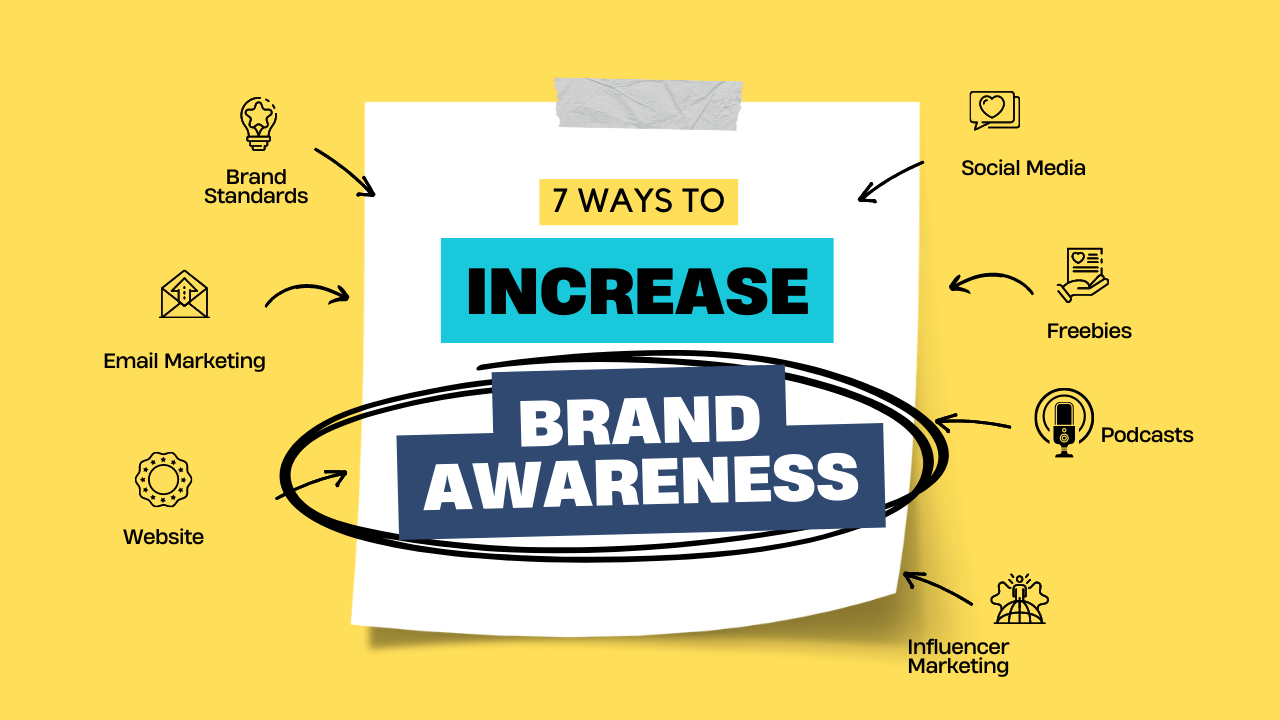7 Ways to Increase Brand Awareness

Picture it. You have a swell idea or product that could turn the world on its head and put a stop to climate change, end world hunger, and bring peace to the Middle East. Where do we sign?
Don’t start writing your Nobel Peace Prize acceptance speech quite yet, friend. Because at the end of the day, it doesn’t matter how good the idea is if nobody knows (or cares) about it.
Enter Brand Awareness.
What is it?
Brand awareness is simply what makes people aware of your very existence and helps set you apart from your competitors. It’s your opportunity to present your products or services in such a way that makes them easily recognizable to customers, as well as establish your authority or expertise.
Why is it important?
It establishes trust with your customers and influences their decision-making processes. The better brand awareness you have, the more valuable your business is. Cha-ching! When you think of dish soap or sneakers or search engines, are you thinking of these in generic terms? Or did your mind immediately go to Dawn, Nike, and Google? That’s the power of brand awareness.
How do you increase brand awareness?
Brand awareness is a beast that needs constant feeding and constant attention. If you’re on a tight budget, the good news is that it can be so much more than just throwing money at advertising campaigns. While companies with more money may have an easier time of it, there are plenty of creative strategies you can implement that are cost-efficient (and sometimes free!) to increase your brand awareness. Here are seven ideas you can use to help get your creative juices flowing!
1. Brand Standards. You need to have a consistent identity across all platforms to be recognizable. (Signage, business cards, logos, social media, etc.) Pick a few complimentary fonts, select a color scheme, and stick with it. It might seem like an inconsequential thing, but it’s just one part of the larger story you’re telling about yourself and your business. If you can’t hire a design expert, Canva.com has thousands of templates, logos, and color pallets to choose from, and the platform is very beginner-friendly.
2. Website. You have to have a website, hard stop. It doesn’t need to be fancy. It doesn’t need to have a ton of bells and whistles. What it does need is to look professional, be easy to navigate, and be simple for visitors to find what they’re looking for. At the very least, you need Contact Information and an About page; this lets people know who they’re potentially getting into business with. Of course, you can do much, much more with a website, but if you’re just starting out - start with the basics, you can always add on from there. Sites like Wix and Squarespace are free and easy website builders that you can set up in just a few minutes.
3. Email Marketing. There’s no easier (or more cost-efficient) way to stay connected with your current customers and reach a new audience than through regular email newsletters. You can drop into their inbox anytime you want with a quick update, promotion, product announcement, customer reviews, educational resources, and more.
4. Social Media. Love it or hate it, social media is here to stay; you might as well use it to your advantage. With 3.78 billion users and 54% of them using social media to research products, it’s a no-brainer. Don’t feel like you have to do them all - at least, not right away. Find the platform that resonates the most with you, then use it to regularly post valuable content that shows customers what you offer. (Pro Tip: If you’re just starting out, consider the demographic you are targeting and check out which platform is recommended and make that your priority.)
5. Freebies. Everyone loves free stuff! (And if they say they don’t, they’re lying.) Your brand can be put on almost anything nowadays, like pens, hats, Frisbees, socks, stickers, travel mugs, keychains, etc. They’re great to have on hand for community events - and it’s an automatic advertisement every time someone wears or uses that product in public. Freebies can apply to digital products as well. Consider providing a free e-book or access to a private Facebook group in exchange for their email address. Not only are you establishing your authority and giving them something of value, but you can also keep them engaged and reinforce your brand through future email marketing. Win-win!
6. Influencer Marketing. People love getting recommendations for products or services. Don’t believe us? (A study a few years ago found that 61% of consumers in the 18-34 age bracket have at some point purchased something because of an influencer. Undoubtedly that percentage has increased since then.) If you can partner with people who have a large social following - especially if they’re already perceived as an expert - they can do wonders to increase and promote your brand awareness.
7. Podcasts. Podcasts have exploded in popularity over the last several years, with new shows getting added every single day in countless niches and industries. Starting your own podcast is a great way to get your message out, connect with others, and establish your brand and authority. If the idea feels overwhelming, consider being a guest on podcasts instead. Sites like Podmatch can help you connect and get booked on shows to reach a variety of audiences.
Remember, brand awareness is all about creating a narrative that establishes your business as an authority or expert in your industry or niche. Don’t worry about doing all of these at once. Start with the one that seems easiest to tackle first, then keep adding on; there is no deadline or timetable - instead, it’s a fluid process that will continue to evolve and change over time.



